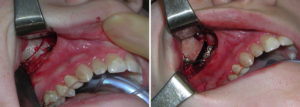People with a narrow-appearing face have often a deficiency in the width of where the upper jaw and cheek meet, known as the cheek or malar complex. The most common and simple method to improve the amount of cheek that one has is to place a cheek implant. There are some patients who do not want a synthetic implant in their face and may ask if there are any other ways to have ‘more cheek’.

The use of this cheek expansion technique is for a very small number of patients. Cheek expansion builds out the side of the cheek but will not bring it forward or add forward projection, which many patients need more than they do width. Having adequate cheek projection but with a narrow face is a very rare cosmetic problem. Furthermore, there are fewer still that want to go through an operation to correct it. For this reason, cheek bone expansion is an operation of more theoretical than practical significance.
Dr. Barry Eppley
Indianapolis, Indiana


